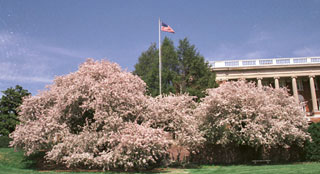Human Flower Project
Monday, May 22, 2006
Sweet Crab
Students rallied to save the crabapple tree at Sweet Briar College, and an alumna planted her own.

The flowering crabs at Sweet Briar College
Photo: Kim Leach
We grew up believing that the gorgeous crabapple tree that stood outside our window in Louisville, Kentucky, was planted when we were born, to grow up alongside us. As a high school senior, we crawled out the bedroom window onto the roof and sat beside its topmost blossoms.
Now we learn that our arrival was likely just part of what inspired planting a flowering crab. Crabapple trees have for 80-some years been living fixtures of Sweet Briar College in Virginia. Three of these trees had grown up tall before the Benedict building, part of the original “Ralph Cram” campus; when a brick wall there was to be restored, the college groundskeepers thought the crabs would have to be pulled out. This was 1999, in April, when a flowering crab can best plead for its life.
According to this account students and faculty petitioned the college president to save the trees, and prevailed. The smallest was removed, but the others survived. “College tree trimmer Richard Canode, in consultation with apple expert Tom Burford, carefully and caringly pruned the two crab apple trees. While he was removing all of the suckers, dead wood, and ivy, he said that he considers these trees among the most valuable on campus.”
Sweet Briar is one of those now very rare institutions—an all women’s college. (We’re guessing there aren’t many colleges where students still dance the May Pole.) Our mother attended the school for one year, back in 1939-1940. She must have enjoyed those crabapple trees next to Benedict and after marrying and settling in Kentucky, chose to plant a flowering crab of her own in Louisville, to celebrate May Day every year.
 Topiaried crabapple
Topiaried crabapple
with Wendy’s
Liberty, NY
Photo: Human Flower Project
Much to the credit of all involved, Sweet Briar’s faculty turn to the crabapples not only for an education in direct action but for nature study, as in this careful observation of bee activity.
Would you like to plant one of these trees? Here’s a good Q&A that may address some of your crabapple thoughts. And a photo of the tree that kicked our own imagination into high gear—a topiaried crabapple we found floating like a pink satellite outside the Days Inn in Liberty, New York.
Finally, we greet our new friends at the beautiful and informative Dias com Arvores, a loving study of trees in Portugal’s landscape and culture. Por favor, show us your crabapples!




